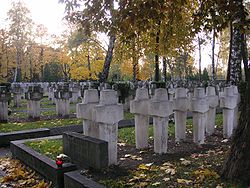
Powązki Military Cemetery
Encyclopedia
Powązki Military Cemetery (pɔˈvɔ̃skʲi; ) is an old military cemetery located in the Wola
district, western part of Warsaw
, Poland
. The cemetery is often confused with the older Powązki Cemetery
, known colloquially as "Old Powązki". The Old Powązki cemetery is located to the south-east of the military cemetery.
The military cemetery holds the graves of many who have fought and died for their country since the early 19th century, including a large number involved in the 1920 Battle of Warsaw
, the September 1939 Campaign
, and the ill-fated 1944 Warsaw Uprising
against Nazi Germany
.
It was founded in 1912 as an annex to the Catholic cemetery, but after Poland regained independence in 1918, it became the state cemetery, where some of the most notable people of the period were buried, regardless of their faith.
A large part of the cemetery is occupied by graves of Polish soldiers who fell in the Warsaw Uprising
. Most of the graves were exhumed between 1945 and 1953 from the streets of Warsaw. In many cases, the names of the soldiers remain unknown, and the graves are marked only by the Polish Red Cross identification number. Until the early 1950s, brothers-in-arms of many fallen soldiers organised exhumations of their colleagues on their own, and there are many quarters where soldiers of specific units are buried. Also in the cemetery are several mass graves of (mostly unknown) civilian victims of the German terror during World War II and of the Warsaw Uprising.
In 1964 communist authorities renamed the cemetery to "Communal Cemetery". The traditional name was restored in 1998.

Wola
Wola is a district in western Warsaw, Poland, formerly the village of Wielka Wola, incorporated into Warsaw in 1916. An industrial area with traditions reaching back to the early 19th century, it is slowly changing into an office and residential district...
district, western part of Warsaw
Warsaw
Warsaw is the capital and largest city of Poland. It is located on the Vistula River, roughly from the Baltic Sea and from the Carpathian Mountains. Its population in 2010 was estimated at 1,716,855 residents with a greater metropolitan area of 2,631,902 residents, making Warsaw the 10th most...
, Poland
Poland
Poland , officially the Republic of Poland , is a country in Central Europe bordered by Germany to the west; the Czech Republic and Slovakia to the south; Ukraine, Belarus and Lithuania to the east; and the Baltic Sea and Kaliningrad Oblast, a Russian exclave, to the north...
. The cemetery is often confused with the older Powązki Cemetery
Powazki Cemetery
Powązki Cemetery , also known as the Stare Powązki is a historic cemetery located in the Wola district, western part of Warsaw, Poland. It is the most famous cemetery in the city, and one of the oldest...
, known colloquially as "Old Powązki". The Old Powązki cemetery is located to the south-east of the military cemetery.
The military cemetery holds the graves of many who have fought and died for their country since the early 19th century, including a large number involved in the 1920 Battle of Warsaw
Battle of Warsaw (1920)
The Battle of Warsaw sometimes referred to as the Miracle at the Vistula, was the decisive battle of the Polish–Soviet War. That war began soon after the end of World War I in 1918 and lasted until the Treaty of Riga resulted in the end of the hostilities between Poland and Russia in 1921.The...
, the September 1939 Campaign
Invasion of Poland (1939)
The Invasion of Poland, also known as the September Campaign or 1939 Defensive War in Poland and the Poland Campaign in Germany, was an invasion of Poland by Germany, the Soviet Union, and a small Slovak contingent that marked the start of World War II in Europe...
, and the ill-fated 1944 Warsaw Uprising
Warsaw Uprising
The Warsaw Uprising was a major World War II operation by the Polish resistance Home Army , to liberate Warsaw from Nazi Germany. The rebellion was timed to coincide with the Soviet Union's Red Army approaching the eastern suburbs of the city and the retreat of German forces...
against Nazi Germany
Nazi Germany
Nazi Germany , also known as the Third Reich , but officially called German Reich from 1933 to 1943 and Greater German Reich from 26 June 1943 onward, is the name commonly used to refer to the state of Germany from 1933 to 1945, when it was a totalitarian dictatorship ruled by...
.
It was founded in 1912 as an annex to the Catholic cemetery, but after Poland regained independence in 1918, it became the state cemetery, where some of the most notable people of the period were buried, regardless of their faith.
A large part of the cemetery is occupied by graves of Polish soldiers who fell in the Warsaw Uprising
Warsaw Uprising
The Warsaw Uprising was a major World War II operation by the Polish resistance Home Army , to liberate Warsaw from Nazi Germany. The rebellion was timed to coincide with the Soviet Union's Red Army approaching the eastern suburbs of the city and the retreat of German forces...
. Most of the graves were exhumed between 1945 and 1953 from the streets of Warsaw. In many cases, the names of the soldiers remain unknown, and the graves are marked only by the Polish Red Cross identification number. Until the early 1950s, brothers-in-arms of many fallen soldiers organised exhumations of their colleagues on their own, and there are many quarters where soldiers of specific units are buried. Also in the cemetery are several mass graves of (mostly unknown) civilian victims of the German terror during World War II and of the Warsaw Uprising.
In 1964 communist authorities renamed the cemetery to "Communal Cemetery". The traditional name was restored in 1998.


